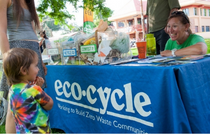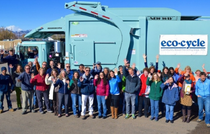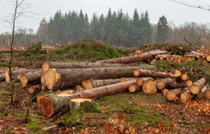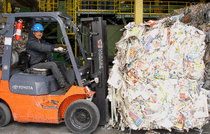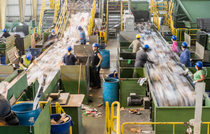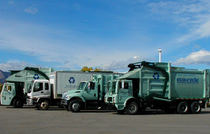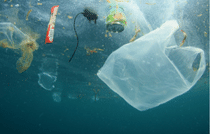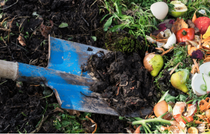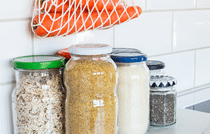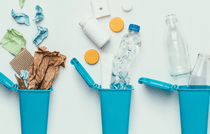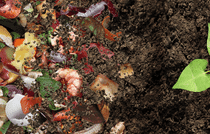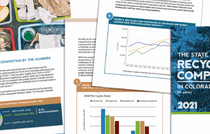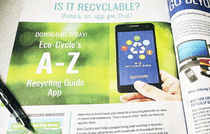These Plastics Are the Most Toxic for Human Health and the Environment
All packaging has environmental drawbacks—paper comes from forests, metals must be mined, and plastics are made from fossil fuels. Reducing overall packaging and food serviceware use has tremendous potential to save water, reduce environmental destruction and climate impacts, and even save businesses money.
One of the most harmful types of plastic packaging is polystyrene (sometimes mistakenly referred to as Styrofoam®), which is made up of multiple styrene molecules. Over fifty chemical byproducts are released during the manufacturing of polystyrene, contaminating the air, water, and communities that work in and live near these facilities. Other plastics that are considered toxic for human health and that have proven to be less recyclable than other plastics include black plastics, and #3 PVC and #7 PC plastics.
Polystyrene (#6 PS)
Bad for Human Health
The US Department of Health and Human Services identifies styrene, a main component of polystyrene, as “reasonably anticipated to be a human carcinogen,” and reports styrene exposure is linked to “increased risks for leukemia, lymphoma, or all lymphohematopoietic cancer.” One of the three greatest sources of exposure to styrene is from eating food contaminated by styrene. How much styrene leaches into food depends on the amount of time the food is in contact with the polystyrene, the amount of surface area where food-to-polystyrene contact occurs, and the type and temperature of the food (higher temperatures and higher fat foods lead to more styrene passing into the food). The Occupational Safety and Health Administration (OSHA) warns that prolonged or regular exposure to the chemicals that make up polystyrene, such as the conditions experienced by people who live near or work in polystyrene factories, can lead to negative effects to the central nervous system, “showing symptoms such as depression, headache, fatigue, weakness,” and potentially causing minor effects on kidney function.
Bad for the Environment
Polystyrene breaks into smaller plastics until it eventually degrades into CO2 and other chemical compounds. Because of its light weight, it is commonly blown or washed into the environment and small pieces can easily be mistaken for food by animals. Once their bellies are full of plastics, animals don’t feel hungry and will starve to death or do permanent damage to themselves.
To reduce the use of polystyrene in Colorado, in 2021 the state passed the Plastic Pollution Reduction Act (HB 21-1162) that bans polystyrene food containers and cups from being distributed at all food establishments in the state, beginning January 1, 2024.
Black Plastics
Black plastics can contain unregulated amounts of toxic chemicals such as phthalates and flame retardants, as well as heavy metals such as cadmium, lead, nickel, chromium, and mercury. That’s because black plastic is largely sourced from electronic scrap such as TVs and computers. If these materials went back into electronic components or into inert uses (such as railroad ties), that would be preferable, but instead they are melted down and mixed with food-grade plastics for applications that pose a higher risk to human health, such as utensils, to-go containers, cooking implements, hot cup lids, coffee stirrers, reusable coffee mugs, or toys for children or pets.
While regulations are in place to ensure your electronic devices do not exceed certain levels of toxic chemicals and metals, there is nothing protecting you from the toxic levels in a black plastic to-go container. Exposure to heat increases the likelihood of these toxic chemicals leaching into your food and drink.
Even at very low levels, these toxic chemicals can cause serious reproductive and developmental problems, poisoning the brain and kidneys, disrupting human thyroid function, affecting development, and causing long-term neurological damage.
Last but not least, black plastics represent a logistical challenge for recyclers that reduces their recyclability. The dark pigment cannot be “read” by optical sorters at recycling facilities that identify and automatically separate different plastic resin types, so the plastics must be sorted manually, increasing sorting costs substantially. Markets that buy plastics for remanufacturing do not like black plastics, because once the plastic has been dyed black, it generally cannot be transformed into any other color of plastic when it is remade into new products.
Polyvinyl Chloride (#3 PVC) & Polycarbonate (#7 PC)
Along with #6 PS (polystyrene) and black plastics, #3 PVC (polyvinyl chloride) and #7 PC (polycarbonate, not to be confused with #7 PLA, polylactic acid, which is a plant-based plastic) plastics are considered among the most toxic plastics to produce, and the most difficult to recycle. Their toxic components pose multiple health risks to humans and other organisms. The components of #3 PVC have been evidenced to be a carcinogen that can cause rare liver cancer, disrupt male endocrine systems, cause short-term lung irritation and dizziness, induce reproductive and birth defects, impair child development, and suppress one’s immune system. Often #7 PC can contain highly dangerous BPA (Bisphenol A). Lab tests show that BPA appears to copy or disturb the hormone estrogen and affect the reproductive system, which could raise the consumer’s risk for cancer.
The Shift Away from Harmful Plastics
Polystyrene, black plastics, #3 PVC and #7 PC plastics are the most toxic and hardest to recycle, and as a mission-based recycler, Eco-Cycle supports shifting products to be made from more recyclable, less toxic plastics including #1 PET, #2 HDPE, and #5 PP. There are no scalable recycling markets for #3, #6, and #7 plastics, now or realistically at any point on the horizon. As we work to strengthen and expand plastics recycling as a key part of the solution to reduce plastic pollution, it is critical that we focus only on materials that have consistent, reliable, and economically viable markets, can reasonably be expected to be returned to manufacturing as a feedstock, and whose recycling does not cause greater harm than good to the environment in other communities in the United States and other countries. In addition to using less toxic, more recyclable plastics in single use items, it is also crucial that we continue to build out reuse systems that reduce all single use packaging.
